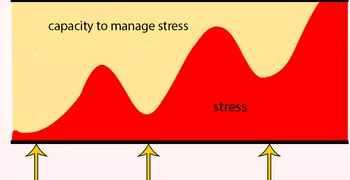Use Mindful Communication to Navigate Holiday Conflicts

 Holiday dinner tables aren’t always as joyful as a scene from a movie. For many, differing opinions on topics ranging from politics to child-rearing styles can quickly sour the mood over a family dinner.
Holiday dinner tables aren’t always as joyful as a scene from a movie. For many, differing opinions on topics ranging from politics to child-rearing styles can quickly sour the mood over a family dinner.
Some people thrive on conflict, enjoying a heated discussion, while others want to avoid it so much they remain silent or even pretend to agree with opinions that don’t actually feel right for them. Do either of these sound like you?
Actually, both of these strategies are misguided. If the goal is to have a meaningful connection, that means listening attentively to things you disagree with and keeping a sense of empathy for the other person. And rather than avoiding difficult conversations, it can actually deepen your relationship to engage in the dialogue skillfully.
But how can you do it?
Mindful communication: A skillful way of connecting
 Many times in conversation, we speak our mind - and then when the other person is speaking, we plan our next comment or try to craft the perfect rebuttal in our heads. As a result, we don’t always fully hear what the other person is saying. This is especially true in an increasingly polarized culture, which journalist Celeste Headlee describes as "more divided than we ever have been in history." She adds, "A conversation requires a balance between talking and listening, and somewhere along the way, we lost that balance. “
Many times in conversation, we speak our mind - and then when the other person is speaking, we plan our next comment or try to craft the perfect rebuttal in our heads. As a result, we don’t always fully hear what the other person is saying. This is especially true in an increasingly polarized culture, which journalist Celeste Headlee describes as "more divided than we ever have been in history." She adds, "A conversation requires a balance between talking and listening, and somewhere along the way, we lost that balance. “
Engaging in a dialogue is a two-way street - listening and responding. Mindful communication means holding an intention to stay fully present and connected to both of these actions, while maintaining a sense of kindness for yourself and the person you are speaking with.
Susan Gillis Chapman, author of The Five Keys to Mindful Communication, uses a traffic analogy to describe conversations. When the two streets of listening and responding are flowing easily, the light is green. But when one person shuts down and isn’t fully listening, or one person isn’t being genuine or honest in their responses, the traffic light turns red - which makes it much easier for conflict and misunderstanding to brew. The goal is to keep traffic flowing both ways, freely and gently.
6 ways to communicate mindfully

Examine your goals for the conversation.
Ask yourself why you are engaging in this dialogue - is it to be right or to learn something? Are you open to having your mind changed, or are you determined to change the other person? If your goal is to remain nonjudgmental and open, you’re on the right track. Mindfulness teacher Oren Sofer says, “One of the most powerful and transformative intentions is the genuine intention to understand, which can build trust, good will, and mutuality.”

Pay attention to your body and reactions.
Keeping a mindful awareness of your own experience during the conversation can help you stay grounded as well as provide insight into whether you are being thoughtful or reactive. For example, a quickening heart and feeling flushed can be signs of strong emotions arising, which can shape what you say. If you notice these sensations, you may decide to take a deep breath to calm down before responding.

Do one thing at a time.
When you are listening, just listen - don’t mentally prepare what you are going to say next.
When you are speaking, just speak gently and honestly - don’t try to control the floor or try to manipulate the other person’s response. And before you speak, ask yourself, "Is that I am about to say true? Is it helpful? Am I going to say it in a way that the other person can understand?"

Be aware of your nonverbal language.
Not all of what you communicate is coming from your words. Looking away while the other person is speaking can send the message that you are not listening, while using aggressive hand gestures while speaking can put the other person on the defense. As you maintain a mindful awareness of your body, pay attention to how you are nonverbally communicating to the other person that you are open, attentive, and calm.

Work from empathy and understanding.
Remind yourself that everyone in the conversation is doing what they think is best. Opinions are shaped from many different sources - personal experience, family and friends, the media. Everyone has a different lens through which they are looking at a situation. Don’t assume you know what the other person’s lens is, or that they understand yours, or that they are the same. Even if the other person says something you perceive as negative, their intention may not be ill will at all. Instead of taking things personally, you can remind yourself that you simply see things differently.

Take a break if you need to.
Sometimes it’s just not productive to continue the conversation right now - perhaps one or both of you is defensive or closed down, and you are in the danger zone of saying hurtful things. Chapman calls this “stopping when the light is red.” It is always okay to say, without assigning blame, “I like talking to you, but I need a break from this conversation now.”
Don’t forget: You can use mindful communication everywhere
While communicating mindfully can be a useful strategy for difficult conversations, it can be practiced anywhere and anytime. Even simple conversations, such as an exchange with the cashier at the grocery store or asking a friend how their day was, are rich opportunities to practice staying present and aware. The more you practice it, the more you build your “mindfulness muscle,” so that when difficult conversations do arise, you feel more confident and at ease.
Chapman, SG. (2012). The Five Keys to Mindful Communication. Boulder, CO: Shambhala Publications.
Headlee, C. (2015). 10 Ways to Have a Better Conversation [Video file]. Retrieved from https://www.ted.com/talks/celeste_headlee_10_ways_to_have_a_better_conversation
Sofer, O. (2019). Four questions to ask yourself before important conversations. Retrieved from https://www.orenjaysofer.com/blog/four-questions.


















